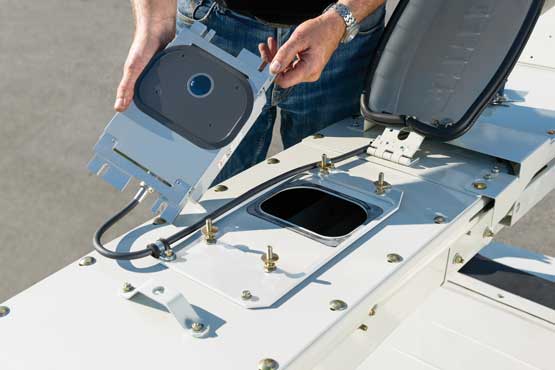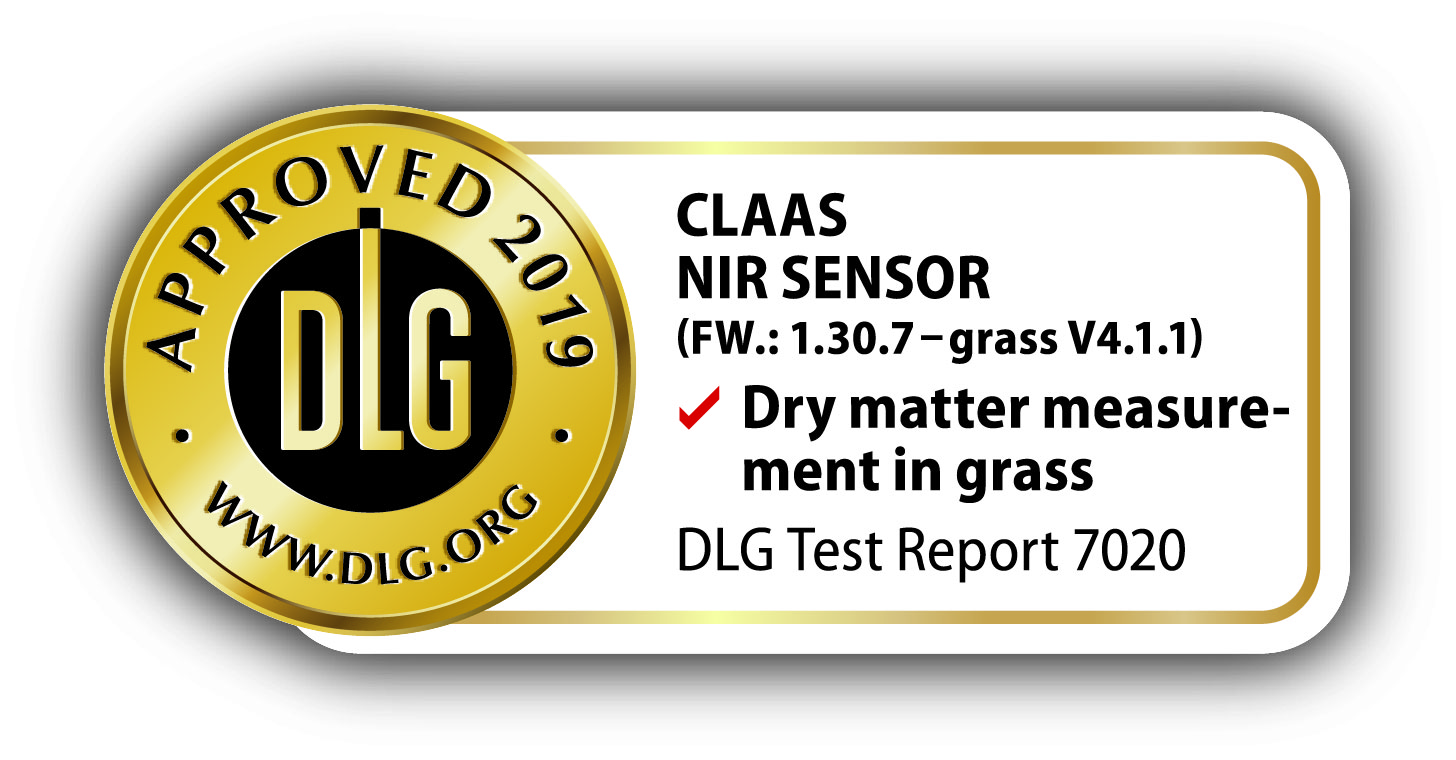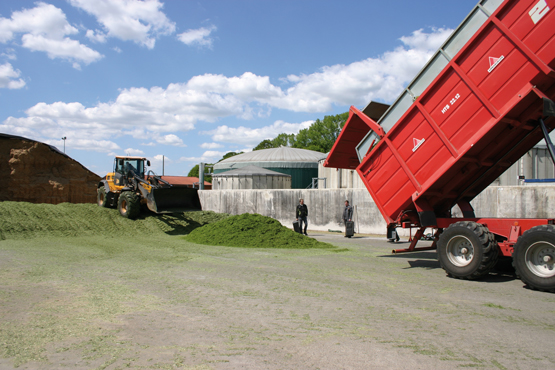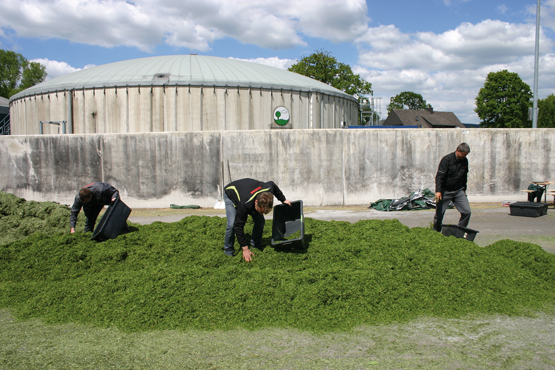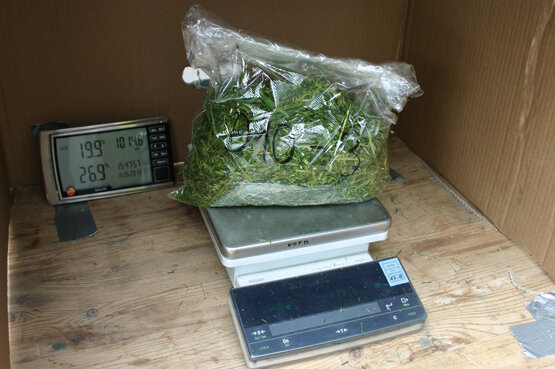CLAAS NIR Sensor - (FW: 1.30.7; calibration model: grass V4.1.1)
DLG-APPROVED: "Dry matter measurement in grass"
The certification mark
A test mark „DLG-APPROVED for individual criteria“ is awarded for agricultural products which have successfully fulfilled a scope-reduced usability testing conducted by DLG according to independent and recognised evaluation criteria. The test is intended to highlight particular innovations and key criteria of the test object. The test may contain criteria from the DLG test scope for overall tests, or focus on other value-determining characteristics and properties of the test subject. The minimum requirements, test conditions and procedures as well as the evaluation bases of the test results will be specified in consultation with an expert group of DLG. They correspond to the recognised rules of technology, as well as scientific and agricultural knowledge and requirements. The successful testing is concluded with the publication of a test report, as well as the awarding of the test mark which is valid for five years from the date of awarding.
The DLG test “Mobile sensors measuring dry matter content in crop as this is flowing through the forager spout and passing the sensors” pairs sensor readings that are taken on the forage harvester with dry matter reference values that are obtained using an official and recognised method and assesses the difference between the values in each pair. The sensor tested by the DLG was a CLAAS NIR Sensor (Firmware: 1.30.7; calibration model grass V4.1.1; model year 2019) which was installed on the spout of a CLAAS Jaguar 860. The test was carried out in May 2019. The test machine harvested two types of grass, each representing a different dry matter range. The fields are located in the federal state of North-Rhine Westphalia, Germany. The test consisted of the forager harvesting and filling ten forage wagons with each crop. The dry matter levels were measured as the material flowed past the sensor on the spout. In a next step, five representative composite samples were taken from each forage wagon as this unloaded the material at the clamp. These composite samples were sent to a contractor lab for analysis by the recognised oven-drying method. The lab results for each wagon filling were used as reference values that were paired with the corresponding sensor readings and the absolute variation in each value pair was computed. No other criteria were tested in this test.
Assessment in brief
On the whole, it was found that over a large 25-47 % range of dry matter content in grass the CLAAS NIR sensor (Firmware 1.30.7; calibration model grass V4.1.1) on the forager spout produced dry matter readings that coincided satisfactorily with the measurements obtained by the official reference method. The difference between the sensor readings and the lab results was less than 3 %abs in all 40 value pairs. In 35 of these value pairs, the difference was even less than 2 %abs. Not one sensor reading exceeded the tolerated variation by more than 4 %abs. in the DLG test.
This means that the spout-mounted CLAAS NIR sensor (Firmware 1.30.7; calibration model grass V4.1.1) meets all requirements for being awarded the DLG APPROVED quality mark for ‘single, value-determining criteria’ for dry matter measurements in grass.
The product
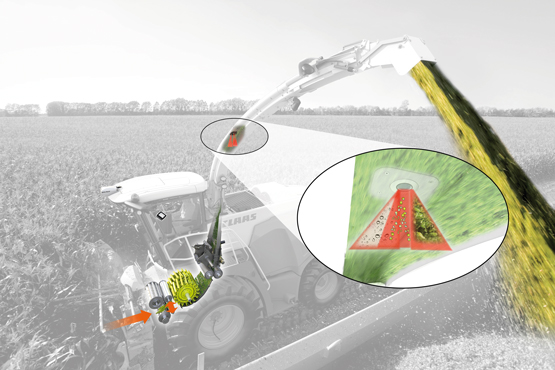
The sensor
The tested sensor uses near-infrared spectroscopy (NIR) to measure the dry matter levels in the crop.
The measurements are made continuously and without interfering with the crop flow as the forager is filling the wagon. The technology is based on a light emitting source that radiates light on the passing crop. Some of the radiation is absorbed by the crop and some is reflected depending on the dry matter level. The reflected light is detected by a meter which disperses it into its spectrum. The spectrum measured is compared with a calibration model that is programmed to the system and optimised to the current crop. The measurements and programmed data are then used to determine the current DM percentage. The calibration models are based on a large number of crop samples that are taken prior to the test. This means operators don’t have to calibrate the system. For maximum accuracy, the system makes 200 measurements per second. The forager’s CEBIS on-board information system uses these measurements to compute one average value every second. It allows operators to retrieve the average dry matter percentage per field from the job count application.
The NIR sensor measures the dry matter content of grass crops within a range of 20.1-74.9 %. In addition to that, it also determines the following feed constituents:
- Crude fat (1.3-3.8 % range)
- Crude fibre (22.7-36.2 % range)
- Crude ash (6.1-18.0 % range)
- Protein (7.9-27.0 % range)
- Sugar (1.9-19.6 % range)
The tested sensor was calibrated to the "grass V4.1.1" calibration model (Firmware 1.30.7).
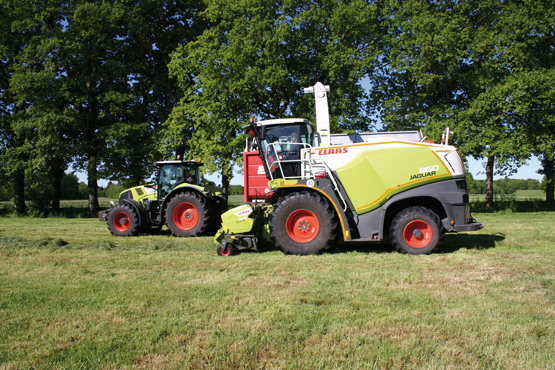
Forage harvester
The forage harvester used in the test was a CLAAS Jaguar 860 with a 3m pick-up. The model is powered by a 12.8-litre Mercedes Benz engine with 390kW (530hp) to ECE R 120 at 1,700rpm (emission stage V).
The engine is mounted transversely to the direction of travel. The chopping drum assembly and the crop flow accelerator are directly driven by a Powerband. Further machine features include an LOC setting system that provides six different chop lengths and a crop accelerator with a mechanical adjuster. The standard specification machine also features the CEBIS on-board information system which – among numerous other features – monitors and logs the sensor data. CEBIS provides job management by field, logging acreage, consumption rates, harvested yields by fresh and dry matter.
The method
The DLG test “Mobile sensors measuring dry matter content in crop as this is flowing through the forager spout and passing the sensors” verifies the accuracy of mobile moisture sensors in grass by comparing the sensor readings with results that are obtained from applying the official reference method (oven-drying method). The spout-mounted sensor is tested in the field as the forager is harvesting and filling a forage wagon. The harvester is set up according to the prevailing harvest conditions. The data for these settings are collected in a number of separate runs prior to the test. The field test is carried out in at least two different types of grass with two different DM spectra. Each to the two test versions sees the forager filling ten forage wagons. The average dry matter content of the crop is determined by the mobile sensors as the grass is flowing through the spout. Then, as the material is unloaded at the clamp, an adequate number of individual samples is taken from each wagon load to form a representative composite sample (Figures 4 to 6). This composite sample is then homogenised. These homogenised samples are split into five representative subsamples and filled into appropriate containers. The fresh mass of these samples is determined as they are filled into the containers. Then the containers are closed, marked and stored in a cooled cabinet. The five subsamples from one wagon are used to determine the fresh matter content to the official oven-drying method at a contractor lab. These wagon-based lab results are then used to compute the average dry matter value to the official method. This averaged value is the reference value. The averaged reference values are then paired with the corresponding sensor readings and the variation between the two values is computed.
Detailed account of the test results
The field test took place on a farm in North-Rhine Westphalia, Germany, in May 2019.
The following four fields were available for the test:
- Field 1: Italian rye grass (DM range: 36-42 %)
- Field 2: Perennial rye grass (DM range: 38-47 %)
- Field 3: Perennial rye grass (DM range: 26-38 %)
- Field 4: Italian rye grass (DM range: 25-27 %)
The various dry matter percentages were obtained by harvesting the grass at different times of the day. The chop length was set to 6.5 mm and was maintained by the machine throughout all test runs.
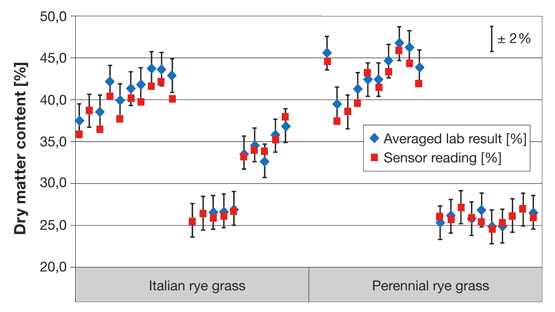
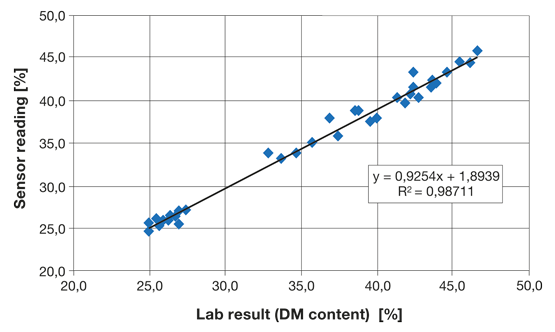
Determining the dry matter content with the CLAAS NIR sensor
Fig. 7 shows the differences between the dry matter readings by the CLAAS NIR sensor and the official reference values. The number of valid test runs in two different types of grass with two different moisture level ranges was 40. The sensor readings are marked red and the lab results are marked blue in the graph. Each lab reference value is assigned a ± 2 %abs tolerance.
All 40 reference measurements produced variations smaller than 3 %abs. In 35 of the 40 pairs the difference between the sensor-based and lab-based data was even less than 2 %abs. The mean variation across all pairs is 1.0 %abs. Not one sensor reading exceeded the tolerated variation by more than 4 %abs in the DLG test.
Across all test runs, the coefficient of determination of the CLAAS NIR sensor relative to the reference measurements was a high R²=0.987 (see figure 8).
Summary
The CLAAS NIR Sensor (Firmware: 1.30.7; grass V4.1.1 calibration model) demonstrated in the DLG test that it meets the requirements for receiving the DLG APPROVED quality mark for dry matter measuring accuracy in grass.
The DLG test “Mobile sensors measuring dry matter content in crop as this is flowing through the forager spout and passing the sensors” shows that the CLAAS NIR sensor (Firmware 1.30.7; calibration model grass V4.1.1) on the forager spout produced readings on moisture levels in two grass varieties that coincided satisfactorily over a large 25-47 % DM range with the results obtained by the official reference method.
All 40 reference measurements produced variations smaller than 3 %abs. In 35 of the 40 pairs, the difference between the sensor-based and lab-based data was even less than 2 %abs. The mean variation across all pairs is 1.0 %abs. Not one sensor reading exceeded the tolerated variation by more than 4 %abs in the DLG test.
Based on these results as obtained in the partial test “Dry matter measurements in grass”, the CLAAS NIR sensor is awarded the DLG APPROVED quality mark.
Manufacturer and applicant
Manufactor and applicant
Manufacturer
m-u-t GmbH,
Am Marienhof 2
22880 Wedel
Applicant
CLAAS Selbstfahrende Erntemaschinen GmbH,
Mühlenwinkel 1,
33428 Harsewinkel
Contact:
Phone: +49 (0)5247 12-0
infoclaas@claas.com
Contact
DLG TestService GmbH - Groß-Umstadt location • Max-Eyth-Weg 1 64823 Groß-Umstadt Germany • Tel.: +49(0)69 24 788-611 • tech@DLG.org

